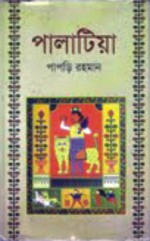| Home - Back Issues - The Team - Contact Us |
 |
| Volume 10 |Issue 17 | May 06, 2011 | |
|
|
Book Review Palatia by Papree Rahman Jackie Kabir
The reader sees the truth in the statement while reading Palatia. Even though the most interesting thing about the book may seem to be the subject of the novel; it is the craftsmanship Papree Rahman uses depicting the language of the actors of Palatia that mesmerizes the readers. The novel is written in the dialect of Dinajpur. The writer expresses the feelings of her characters with the language. Palatia is a kind of act which is specific to its birthplace, Dinajpur. The producers, directors and the actors all come from poverty stricken families. The stage used in this kind of act is known as central staging or arena theatre. The Greeks used to act on stages like that. In recent years American stage director Margo Jones introduced this in-round- theatre in 1947.There is no screen and the actors come in and out of the stage from the audience. The plays are mostly staged at night so they use hajoc or lantern. The weather in the northern side of Bangladesh is very dry. Papree Rahman begins her novel by giving description of this dry land. The ground here is very rough. Even then it shows different views at different times of the year. It has myriads of facets for each season like, the rivers Dhepa, Tulai, Punorbhoba & Khorkhoria all comply to the changes of the seasons. And this is what intrigues the author. Each chapter is titled by rhyming verses of one or two lines. There are numerous characters in the book, all of whom are bound together by the act, the play that they work on. Mongolchondro, the producer and director is an illiterate person. He dictates the acts and Horendro, writes it out. Even though Horendro invests much physical labour in the plays, it is Mongolchondro who gets name, fame and money. Mongolchandra's wife Nonibala aptly maintains the household, whereas Horendro's wife Mayarani is frustrated with her husband's lack of recognition. Bishooraam, is the hero of the play Matikapa-Dewniya. He seems to be in a state of trance all the time, his wife Chonchola spends her days with her four children and her mother-in-law who remains unfed or half-fed. But Bishooraam never pays any heed to that. Resulting in Chonchola's strong hatred for the act and the actors. She goes to the extent of going to Mangolchondo's house and abusing his wife for ruining the family by giving him the part of hero in his play. Nayanjoli lost her mother at birth, her neighbour Gauri looked after her and brought her up as her own. She was beaten up by her husband Bhubonmohon for doing that. Gauri somehow gets entrapped in a relationship with Nayanjoli's father Krisnonath. A relationship that has no name. Nayanjoli is physically assaulted by Bhubonmohon while she is alone in the garden. Her shriek makes Gauri run to the spot where she finds Nayanjoli spitting on her husband. That enrages Bhubonmohon so much that he beats her almost to death. Padmanath and Bijoya have an airy relationship even though they were bound together by the social institute called marriage. Since they have no children they are almost like a couple just living under the same roof rather than sharing their lives. So when casanova Monoronjon meets Bijoya he wastes no time to get close to her. They have to flee their village as Padmanath catches them lying in each other's arms 'like a pair of snakes.' Padmanath wounds him with his sickle before he can run away. Finally the night when the play Matikapa-Deoniya is supposed to be staged in Hatmadhobpur, Chancala wife of the hero commits suicide. She drenches herself in kerosine and burns herself along with her four children. It is a sad but close-to-real life story. The writer has gone to the trouble of doing extensive research on the actors of Palatia. The craftsmanship of the author is visible as most of the book is written in the dialect of Dinajpur. Even though there are numerous characters in the book, when the reader finishes it, almost all of them are familiar characters. Through the farmer Padmanath the writer brings in the incident of Tebhaga, when the farmers wanted two third of the crop they produced. This gave rise to unrest and hundreds of farmers were arrested, some were killed. All this took place in the northern region of Bangladesh. Papree Rahman carefully portrays the homosexuality in the male actors of the play. What is commendable in her writing is that she writes about the subaltern. The actors of the play are from the poorest of the poor in the society. They fail to provide their families with the bare necessities yet they act for their play. They entertain people when their families go to sleep starving. Who would tell their stories had writers like Papree Rahman not put the ink on the paper for them? It's a good read and a record of one of the major components of our rural tradition.
Copyright
(R) thedailystar.net 2011 |
 F
F